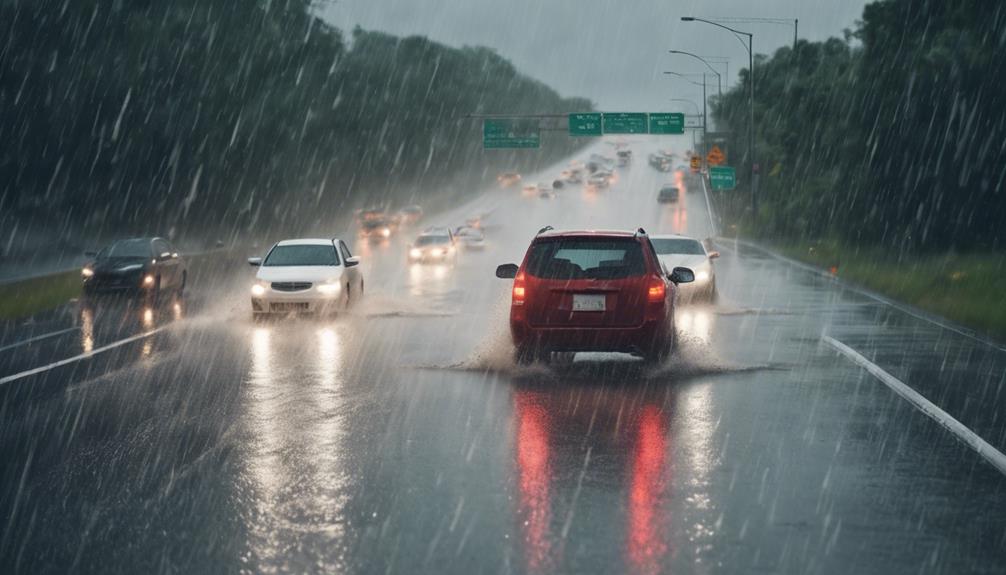How Weather Influences Highway Conditions: A Guide
When facing the open road, weather can swiftly transform your driving experience. Rain, snow, fog, wind, and extreme heat all play pivotal roles in shaping highway conditions.
As you navigate through these elements, understanding how weather influences the state of the road ahead is crucial for your safety and the safety of those around you.
By exploring the intricate relationship between weather and highways, you'll gain valuable insights that could potentially save lives.
Types of Weather Conditions Affecting Highways
Frequent heavy rain can significantly impact highway conditions, leading to increased risks for drivers. When thunderstorm hazards accompany heavy rain, the dangers multiply. In these conditions, visibility decreases, roads become slippery, and the risk of hydroplaning rises. Drivers must exercise caution to prevent accidents.
Hail damage is another concern during thunderstorms. Hail can range in size from small pellets to large stones, causing harm to vehicles on the highway. Windshields may crack, bodywork can dent, and paint may chip, all of which can compromise the safety and integrity of the vehicle. When driving in hailstorms, it's advisable to find a safe place to pull over until the storm subsides.
To minimize the impact of thunderstorm hazards and hail damage on highways, it's essential for drivers to stay informed about weather conditions before embarking on a journey. Checking weather forecasts and road conditions can help individuals make informed decisions about when it's safe to travel. Remember, your safety and the safety of others on the road should always be a top priority when facing adverse weather conditions.
Impact of Rain on Road Surfaces
When rain falls on highways, it can have a significant impact on the road surfaces, affecting driving conditions for motorists. The presence of water on the road increases the risk of hydroplaning, where your vehicle loses traction and slides uncontrollably. This is particularly dangerous as it can lead to accidents due to the loss of steering control and braking effectiveness. To reduce hydroplaning risks, it's crucial to slow down and avoid sudden maneuvers when driving in wet conditions.
Moreover, rain can accelerate pavement deterioration. The constant exposure to water weakens the asphalt and can lead to potholes, cracks, and rutting on the road surface. These imperfections not only make for an uncomfortable ride but also pose hazards to vehicles, causing accidents or damage. It's essential for highway maintenance crews to regularly inspect and repair road surfaces to ensure the safety of drivers during and after rainy periods.
Dealing With Snow and Ice on Highways
Navigating highways during winter poses challenges due to the presence of snow and ice, requiring drivers to adapt their driving techniques for safety. Winter maintenance plays a crucial role in ensuring that highways remain navigable during these harsh conditions. Road crews work tirelessly to clear snow and ice, making the roads safer for drivers. Effective snow removal involves plowing, salting, and sanding to prevent slippery surfaces and improve traction.
When encountering snow and ice on highways, it's essential to adjust your driving behavior. Reduce your speed and increase your following distance to allow for more reaction time. Be gentle on the brakes to avoid skidding, and accelerate slowly to prevent wheel spin. Keep a lookout for shaded areas where ice is more likely to accumulate. Remember that bridges and overpasses freeze first, so approach them with caution.
During winter months, stay informed about weather forecasts and road conditions before embarking on a journey. If possible, postpone your trip if conditions are severe. If you must drive, ensure your vehicle is equipped with winter tires and carry emergency supplies. By being prepared and adjusting your driving habits, you can safely navigate highways affected by snow and ice. Stay vigilant, patient, and always prioritize safety.
Effects of Fog on Highway Visibility
Be cautious when driving through fog on highways, as it significantly impacts visibility. In foggy conditions, driving hazards increase, requiring you to prioritize fog safety and follow visibility tips to ensure a safe journey. When encountering fog on the highway, reduce your speed and increase the following distance between you and the vehicle ahead. This simple action can prevent accidents caused by limited visibility.
Ensure that your headlights are on low beam to avoid glare reflecting back at you in foggy conditions. High beams can scatter light, making it harder to see, so stick to low beams for better visibility. Use fog lights if your vehicle is equipped with them, as they're designed to cut through fog and improve visibility close to the ground.
Be extra cautious when changing lanes or merging onto the highway in foggy conditions. Use your turn signals earlier than usual and shoulder-check to ensure there are no vehicles in your blind spot. Avoid sudden movements or abrupt braking, as these actions can lead to accidents due to reduced visibility.
Wind and Its Influence on Driving
In windy conditions on highways, adjusting your driving technique becomes crucial to maintain control and stability. Wind resistance can significantly impact your vehicle's stability, especially when traveling at higher speeds. Crosswinds, in particular, pose a challenge as they can affect your steering control, making it important to be prepared for sudden gusts that may push your vehicle off course.
To counteract the effects of wind resistance, ensure that you have a firm grip on the steering wheel and maintain a steady speed to help stabilize your vehicle. Keep both hands on the wheel and be prepared to make small adjustments to keep your vehicle in the intended lane. It's also advisable to increase your following distance from other vehicles to allow for more reaction time in case of sudden gusts or lane deviations.
When encountering strong crosswinds, try to anticipate their direction and adjust your steering preemptively to counteract their force. Be cautious when passing large vehicles like trucks or buses, as their size can create wind tunnels that may affect your vehicle's stability. By staying vigilant and proactive in your driving approach, you can navigate windy conditions on highways with greater confidence and safety.
Extreme Heat and Highway Safety
When driving in extreme heat on highways, staying hydrated is essential for your safety and well-being. The scorching sun can significantly elevate pavement temperatures, impacting safety on the road. In hot weather, it's not just you who feels the heat; asphalt also suffers. The intense heat can lead to asphalt degradation, causing roads to become brittle and prone to cracking, which can compromise your driving experience.
To ensure your safety during extreme heat conditions, it's crucial to be aware of the potential hazards posed by high pavement temperatures. The heat can make the road surface more slippery, affecting your vehicle's traction and braking distance. Additionally, the risk of tire blowouts increases as the hot pavement puts extra stress on your tires.
To combat the challenges of extreme heat while driving, make sure to keep your vehicle well-maintained, especially checking your tire pressure regularly. Adequate tire pressure is vital for optimal performance, particularly in high-temperature conditions. Furthermore, avoid prolonged exposure to the sun by using sunshades and wearing appropriate clothing to prevent heat exhaustion.
Handling Storms and Heavy Rain

Driving in stormy conditions or heavy rain requires heightened caution and adaptability to ensure safety on the highway. When faced with such weather, visibility is often reduced, and roads can quickly become slick and hazardous. To navigate these challenging conditions safely, it's crucial to adjust your driving behavior accordingly.
Flood management is a critical aspect of handling storms and heavy rain on highways. Heavy rainfall can lead to flash floods, causing water to accumulate rapidly on roadways. To mitigate the risk of hydroplaning or losing control of your vehicle, it's essential to avoid driving through flooded areas. Turn around and find an alternate route if you encounter standing water on the road.
Emergency response plays a vital role in ensuring the safety of both drivers and passengers during stormy weather. In the event of a weather-related emergency, such as a sudden downpour or a storm causing debris on the highway, it's important to stay calm and contact the appropriate authorities for assistance. Additionally, being prepared with emergency supplies in your vehicle, such as a flashlight, blankets, and non-perishable food, can help you stay safe until help arrives.
Implications of Temperature Changes
Navigating stormy conditions and heavy rain on highways requires heightened caution and adaptability to ensure safety. As temperatures fluctuate, the implications on highway conditions become increasingly significant. Temperature fluctuations play a crucial role in determining the state of highways. When temperatures shift dramatically, it can lead to various challenges for road maintenance.
Extreme heat can cause roads to expand and crack, making the surface uneven and potentially hazardous for drivers. Conversely, during freezing conditions, roads can contract, resulting in potholes and fissures that compromise the road's integrity. These temperature-related road issues not only pose risks to drivers but also necessitate prompt maintenance to prevent further damage.
Proactive road maintenance is essential to mitigate the effects of temperature changes. Regular inspections, especially after extreme temperature shifts, can help identify and address issues promptly. Repairs such as filling cracks, patching potholes, and resurfacing damaged areas are crucial to ensuring the safety and usability of highways. By prioritizing road maintenance in response to temperature fluctuations, authorities can uphold the quality of highways and enhance overall road safety.
Frequently Asked Questions
How Do Wildfires and Smoke Impact Highway Conditions?
When wildfires rage, the impact on highway conditions can be severe. The smoke hazards lead to reduced visibility, making driving dangerous. It's crucial to stay informed about road closures and advisories during such events.
Remember to prioritize safety and consider alternative routes if needed. Your safety and the safety of others on the road are paramount when navigating through areas affected by wildfires and smoke.
What Precautions Should Drivers Take During Thunderstorms and Lightning Strikes?
When driving during thunderstorms and lightning strikes, you must be cautious. Watch out for flooded roads that can reduce visibility.
Wet pavement increases the risk of hydroplaning, so drive slowly and avoid sudden maneuvers.
If visibility is poor, pull over safely until the storm passes. Remember, safety first during severe weather conditions on the road.
Are There Specific Guidelines for Driving During Hailstorms?
When driving during hailstorms, it's crucial to stay safe. Hail can lead to reduced visibility and slippery roads, making it harder to maintain control of your vehicle. Remember to slow down, turn on your headlights, and pull over to a safe location if the conditions become too severe.
Always prioritize your safety and the safety of others on the road during snowstorms, fog, and any challenging weather conditions.
How Does Smog and Air Pollution Affect Highway Safety?
When smog and air pollution levels rise, highway safety is compromised. Visibility hazards from smog can make it difficult to see, increasing the risk of accidents.
Additionally, poor air quality can lead to health risks for drivers and passengers. Traffic congestion often worsens during smoggy conditions, making travel slower and more dangerous.
It's important to stay informed and take precautions to minimize the impact of smog on highway safety.
What Are the Effects of Earthquakes on Highways and Road Infrastructure?
When earthquakes strike, highways and road infrastructure face serious challenges. Landslide risks increase due to the tremors, potentially blocking roads.
Bridge stability can be compromised, leading to collapses and obstructed paths. It's crucial to assess and repair damages promptly post-quake to ensure safe travel.
Stay informed and exercise caution when navigating these post-earthquake hazards on the roads.
Conclusion
Overall, weather plays a significant role in determining highway conditions. From rain and snow to fog and wind, each type of weather condition presents its own challenges for drivers.
By being aware of how weather can impact highways and adjusting driving habits accordingly, you can better ensure your safety and the safety of others on the road.
Remember to stay cautious and prepared for changing weather conditions while driving on highways.
